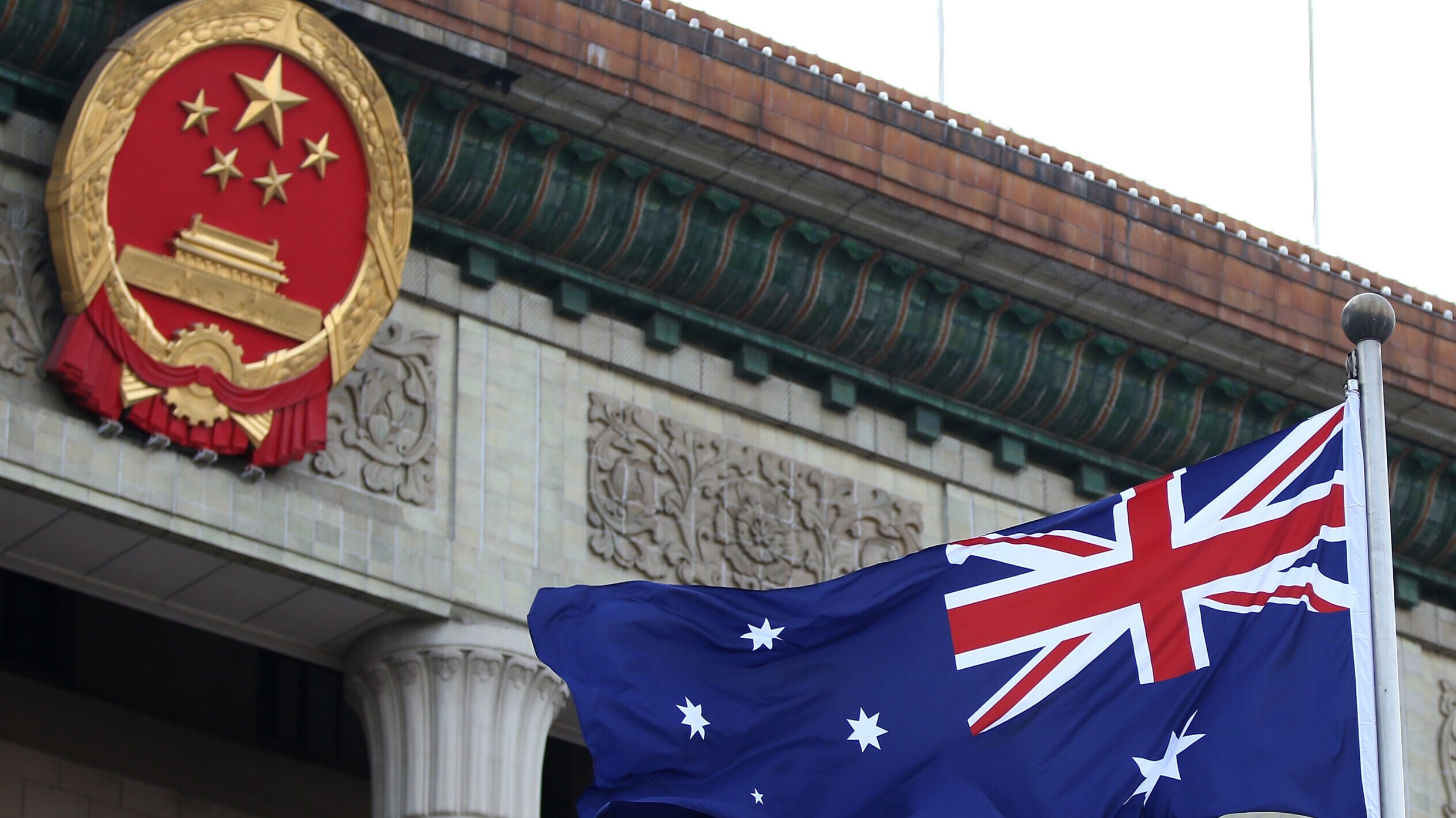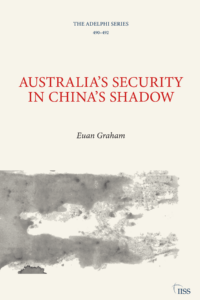
An Australian flag is seen during a welcome ceremony for then-Australian Prime Minister Julia Gillard outside the Great Hall of the People on April 9, 2013 in Beijing, China. (Feng Li/Getty Images)
In its complicated and fraught relationship with China, Australia now faces its most important strategic challenge since the Second World War, one which manifests itself both domestically and externally. In a new book, “Australia in China’s Shadow,” expert Euan Graham grapples with the nature of these challenges and seeks to assess the efficacy of Canberra’s policy responses. Below, he lays out some of the top-line issues discussed in greater detail in his book, which is now available.
Australia offers a useful “canary in the coalmine” comparator, especially for small and medium-sized states that are facing a similar set of challenges from China. Canberra’s response in the face of increasingly hostile behavior from Beijing suggests the possibility of a loose template for other states seeking to protect themselves against a combination of political interference, coercive economic policies and other forms of pressure. There is enough experiential overlap for other countries, particularly among the advanced democracies, to draw general lessons and calibrate policy responses appropriate to their own circumstances.
In the hard-security realm, China is increasingly the focus of Australia’s defense planning. Canberra has recently reordered its defense and alliance policy settings in response to the rising potential for China to exert military pressure, indirectly or directly, against Australia’s interests. Under the 2020 Defence Strategic Update (DSU), Australia has committed itself to boost its conventional deterrent capabilities significantly and to concentrate on the defense of its immediate region with an intensity not matched in more than half a century.
Canberra has responded to the perception of a more threatening China by significantly boosting its military spending, enhancing its conventional deterrent with new, longer-range strike capabilities and strengthening military integration within the US alliance. By jettisoning its ten-year ”strategic warning time” as a basis for defense planning, Canberra has indicated that it sees China as a potentially serious military threat emerging within that time frame. Australia’s 2020 DSU update sent a clear message that it is time to prepare in earnest, subsequently amplified in 2021 by the Australia–United Kingdom–United States (AUKUS) strategic-technology partnership arrangement.

The cover to Euan Graham’s “Australia in China’s Shadow.” (Courtesy Euan Graham)
The biggest problem now confronting Australia’s defense policy, and specifically its mission to deter Chinese adventurism, is the glaring disjuncture between the end of the strategic warning time and the introduction of new military capabilities that are currently planned for the Australian Defence Force (ADF). This ”capability gap” applies most conspicuously to the future Australian-built nuclear-powered submarine fleet, under AUKUS. Increased forward-basing of US forces — including nuclear-powered attack submarines (SSNs) — in Australia is the most obvious solution to short-circuit the looming capability gap. The US alliance thus retains its strategic centrality for Australia — another own goal for China’s resort to open coercion.
The main purpose of Australia’s heightened deterrence posture is to influence the risk calculations of China’s leadership about the use of military force. The ADF lacks the mass of Japan’s Self-Defense Forces, but nuclear-powered submarines with the capability to interdict China’s resource supply routes across the Indian Ocean, and/or to loiter undetected off China’s coastline, sinking Chinese warships and submarines and striking military bases directly, might alter Beijing’s calculus concerning the use of force to achieve national objectives.
Another factor that will doubtless shape Beijing’s calculus is the strength of Australia’s alliance with the US. Canberra’s decision to lock itself into a long-term strategic partnership with the US and UK on nuclear submarines, under AUKUS, signals the reinforcement of the alliance. This signal appears to have been amplified by Canberra’s decision to allow American and British SSNs to operate from HMAS Stirling, near Perth in Western Australia, among other enhancements to the US military posture in Australia. Australia has a unique, but until recently latent, locational value for the US, as an island continent with coastal frontage on both the Pacific and Indian oceans and proximity to archipelagic Southeast Asia to the north. Australia remains a long way from East Asia’s most obvious conflict flashpoints, but it is a politically secure, continent-sized staging ground from which to project US combat power into Asia or safely disperse it to the rear.
In addition, Australia’s SSNs would constitute a potent stand-alone offensive capability, in the unlikely, but not unthinkable, scenario that China exerts military pressure on Australia directly and US combat support is unavailable because of urgent commitments elsewhere.
China’s challenge is sufficiently extensive that it is simultaneously playing out as a challenge to Canberra’s statecraft in the two sub-regions of the Indo-Pacific that are closest to Australia and most central to its security: maritime Southeast Asia and the Southwest Pacific. For Australia to meet the scale and complexity of the challenges that China poses, a broad-based and sustained effort will be required across the Indo-Pacific to boost Australia’s influence and achieve a defense posture that contributes to a favorable balance of power and facilitates the forward deployment of the ADF. Converging threat perceptions regarding China are also bringing Australia into closer strategic alignment with Japan and India.
Australia has provided an imperfect but nevertheless useful exemplar of how governments can respond effectively to China’s multifarious security challenges. However, the Australian case also suggests that a coherent response to China’s security challenges at the international level must be based on firm foundations for addressing domestic vulnerabilities.
Euan Graham is the Shangri-La Dialogue Senior Fellow for Indo-Pacific Defence and Strategy at the International Institute for Strategic Studies. Australia in China’s Shadow can be purchased by clicking here.






















